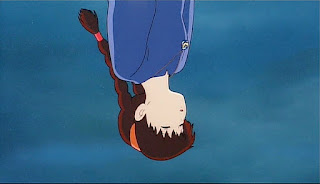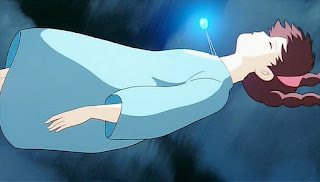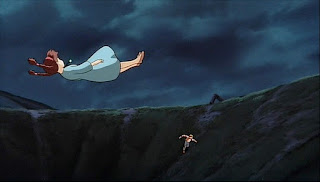Introduction:
Two years after his massive
post-apocalyptic science fiction adventure Nausicaaof the Valley of the Wind , director Hayao Miyazaki brought a different
kind of adventure to the big screen. This turned out to be a unique film in
many ways. It looks into Miyazaki’s past work and also gives us a glimpse of
the future. In so many ways Castle in
the Sky plays like a greatest hits of Miyazaki’s work, before he had even
completed enough work to create a greatest hits. But a greatest hits film from
one of the masters of animation means we have a pretty good movie to look at.
Summary:
In a world very similar to
ours during the industrial revolution a young man named Pazu (James Van Der
Beek) is toiling away as an engineer’s apprentice. His job is to keep the
mining machines in good order. But
his ordinary day is interrupted so he can catch a glowing girl who falls from
the sky! Her name is Sheeta (Anna Paquin). She tells Pazu that she is being
pursued by dangerous sky pirates lead by the notorious Dola (Cloris Leachman) and
a sinister government agent Muska (Mark Hamill).
Pazu decides to help Sheeta
evade both parties, and the two find themselves falling in an out of peril.
They’ll delve into the depths of the mysterious mines, fly in soaring airships,
do battle with pirates and even encounter a bizarre robot. This mechanical
being is supposedly from the famed floating city of Laputa. And Sheeta may be
the only person alive who is able to unlock the mystery of this legendary land.
But is the secret of The Castle in the
Sky a blessing or a curse?
Good Points:
- An amazing world visualized
in both production design and sweeping action
- A powerful symphonic score
by Joe Hisaishi
- Maintains a fun action
packed adventure feel through the whole film
Bad Points:
- Can go from dramatic to
incredibly goofy at the drop of a hat
- The original score may
contain too many 80s synths for some viewers
- Tries to do too many things
and ends up losing some of its impact
Overall:
After the dark mythic saga
of Nausicaa, Miyazaki went for
something more fun and light. He creates a memorable steampunk world before
steampunk was even a thing. Pazu and Sheeta are delightful characters you
immediately care about. Their adventures and perils are entertaining and well
realized. But the movie seems to shift from pure adventure to slapstick comedy
a few too many times. There are so many elements in play that no one part ends
up really sticking. As a result, I always enjoy watching the film, but it is
one that I tend to forget about when I want to revisit a Miyazaki film.
Scores
(out of 5)
Visuals: 5
Sound: 4
Acting: 4
Script: 4
Music: 4
Direction: 4
Entertainment: 4
Total: 4
In Depth Review
 |
| Gulliver never had an adventure like this. |
This is a strange movie for
me. I know it has a lot of fans and some folks consider it one of the best in
Studio Ghibli and Miyazaki’s filmography (something that can be said of nearly
every movie in that filmography). Castle
in the Sky is a movie that is filled with great ideas and is a lot of fun
to watch, but lacks sticking power. As you can see from my ratings there is
nothing particularly wrong with it. If this movie was presented by another
studio it may be considered a classic. But when placed in the same group as Spirited Away, Princess Mononoke, and My
Neighbor Totoro it ends up falling into the shadows.
I think I know why that
might be, but before I delve into that, let’s take a look at the film in all
its parts.
 |
| The little red engine that could. |
Like Nausicaa of the Valley of the Wind before it, Castle in the Sky is a marvel of design and visual splendor.
Miyazaki takes us to a world in the middle of their industrial revolution and
pushes the concepts to some interesting places. The mining town Pazu lives in
is inspired by coalmines in Wales. In fact much of costume design and settings
in this film are based on a very European look. Miyazaki started this with Castle of Cagliostro and could continue
using this visual approach up to Howl’s
Moving Castle. The mining town is built in and around deep crags in the
earth. There are plenty of steam-powered machines around, including a plucky
little train that is used in one of the many chase scenes of the film.
The first portion of the
film keeps us on the ground and then deep inside of the earth as Pazu and
Sheeta escape into an abandoned mine. This underworld scene is filled unique
visuals, including glowing rocks and enormous caverns. It reminds me of the
world under the toxic forest in Nausicaa.
 |
| Dola's pirate ship has a beak! |
But Castle in the Sky really takes off when we hit the skies. Muska and
his government forces use enormous war dirigibles that wouldn’t be out of place
in Nausicaa either. The sky pirates,
commanded by the grouchy Dola, have unique insect and bird inspired vehicles
they operate. Then you have the enormous and visually stunning flying island of
Laputa itself.
While the name of the flying
island comes from Jonathon Swift’s Gulliver’s
Travels, the design doesn’t look like it came from the age of reason. The technology
we see at work in Laputa contrasts to the steam and gear powered machines used
in the rest of the film. Laputa is a world powered by nature and by some kind
of unique energy source found in the mysterious stones that Sheeta can
activate. Is this some kind of biological connection to the earth that the
people of Laputa were able to wield? It is never explained. Visually it makes
for such a difference: clean and vibrant compared to the coal and smoke we see
earlier.
 |
| The airship Goliath searches for trouble. |
Once again Miyazaki’s fascination
with flight is on full display. He uses many of the visual styles and
techniques for the thrilling dogfights in Nausicaa
of the Valley of the Wind and
expands on them. Castle in the Sky is
filled to bursting with intense aerial action. All of it looks great and is so
impressive for hand drawn animation from 1986.
Equally impressive are the
chase scenes in the first portion of the film. Many of these remind me strongly
of his fun car chase scene that opens Castleof Cagliostro. There is a mix of intense speed, cartoon physics and
surprising maneuvers that keep everything light and frothy, but also keep the
momentum moving.
 |
Sheets and Pazu take a quick break from the various
perils. |
That is one of the keys to Castle in the Sky. The movie moves at a
brisk pace, jumping from one adventure and set piece to the next. There are few
moments where things slow down, such as when Sheeta is captured by Muska, or
when Pazu and Sheeta explore Laputa for the first time. Miyazaki is known for a
leisurely pace in most of his films. With this movie falling into the action
adventure category he makes sure something exciting is always happening or
about to happen.
When it comes to sound
effects, this film does a solid job. Most of what you hear is real world sound.
It helps ground the viewer and gives weight to the film. In fact many of the
machines in the movie feel more realistic because of the sound design for them.
The only place where we get unusual sound is for Laputa and its unique
technology.
 |
| The wonders of the underground cavern are revealed. |
In 1986 Studio Ghibil wasn’t
yet the powerhouse of animation that it would become after the release of My Neighbor Totoro. As such they didn’t
have the budget for a full symphonic score. Miyazaki turned to his collaborator
for Nausicaa of the Valley of Wind,
Joe Hisaishi to bring Castle in the Sky to
life. But with a tight budget he had to rely heavily on synths. In most cases
this wouldn’t be a problem, but with a film so rooted visually in late 1800s it
feels natural to have something a bit more orchestral.
 |
| Is the robot an enemy or a protector? |
In a way it doesn’t really
matter. Hisaishi crafted some wonderful music for Castle in the Sky. His main theme for the film is one of his most
beautiful pieces, and he uses it throughout the film, adding a feeling of
wonder to many key scenes. The postcredit scene would not be as impactful
without this theme and this performance. When Disney obtained the rights to
release Castle in the Sky with a new
dub, they brought in Hisaishi to rework the score with a full orchestra and add
an additional 50 minutes of music. They wanted to give this film a theatrical
release after they released Princess
Mononke in theaters in 1997. They felt a symphonic score would add to the
grandeur of the film. I have to
say in many ways they were right. For the most part the new score backs the
action really well. There are a few moments where the score seems to be a bit
too much. But Hisashi is a lot like James Horner, he always goes for the
emotion, and he usually goes big. On DVD you can hear the original synth score
if you watch with the Japanese dub, and hear the symphonic if you watch the
English Dub.
 |
| Muska's greed endangers everyone on Laputa. |
Speaking of the dub, well it
is a bit controversial. As I mentioned the movie moves pretty quickly and you
may find it difficult to keep up with the subtitles. But if you pick the
English dub you’ll notice right away that Pazu and Sheeta sound a bit older
than the characters look. Disney opted to have them dubbed as pre-teens, and in
Japanese they are obviously children. In addition, the English dub has a lot of
the background characters providing a lot of additional chatter (especially
during the sky pirate scenes). Some of it is pretty amusing, but the result is
a noisy dub (something that Kiki’s
Delivery Service also suffers from). Disney eventually stopped trying to
overcook the English dubs. Honestly I’m not sure this a deal breaker to anyone
but anime fans. It is a solid dub, and Mark Hamill provides an excellent
performance as the dastardly Muska. Plus you get the gorgeous symphonic score
with the English dub.
That said, a well informed reader, Jon, informed me that Disney made some changes to later releases of Castle in the Sky on DVD. The first DVD release (from 2004) contains both the original Japanese and English dub as it was first released (with the symphonic score). The 2010 Region 1 release drops the symphonic score and cuts a lot of the added chatter to bring the dub script closer to the Japanese. But other regions retain the symphonic score but contain the de-chattered dub. The Disney Blu-ray is also missing the symphonic score. So if you want to see the film with that version of the score, you might want to seek out the 2004 DVD release.
 |
Sheets and Pazu discover another puzzle on the
castle in the sky. |
Castle in the Sky was the first official film from Studio Ghibli. As such Miyazaki needed
this to be a success so he could continue his path to creating a major
animation studio. His approach was to craft an adventure film the whole family
could enjoy. Nausicaa was a visually
impressive film with overtones of darkness and a heavy mythological and
ecological message. Miyazaki wanted to keep things more fun and light, but
still include an ecological theme to the movie (something that appears in
nearly all of his movies in some form). In addition, he also wanted to comment
on human desire to advance technology no matter the cost.
The final result is a script
that has a great adventure at its heart, and one that carries the film forward
with great skill. But it has too many underlying themes that end up fighting
for attention and a place in the final product. This makes the movie vary in
tone. One minute we are goofing around with sky pirates and cracking silly
jokes. The next we are talking about civilization destroying weapons and
subjugating nature.
 |
The power Sheeta channels is what Muska wants
most! |
Muska is a real nasty
character, one that will threaten innocent people and children to get what he
wants. Castle of Cagliostro had a
similar issue, but I think it worked better because the main characters were
all rogues and most of them were adults. The danger and the cartoon humor was
odd, but it didn’t’ seem wrong. But when you put children in real danger all
the cartoon slapstick feels out of place to me. This kind of wild tone shift
would be toned down in future films. But I think that Castle in the Sky could have used a tighter script. As amazing as
the visuals are, they end up being the part of the film I always remember most,
and story just kind of slips away.
 |
Is destruction the only solution to the power within
Laputa? |
What struck me during
this viewing was how much of this film would create seeds that would spring up
into full bloom in later Miyazaki films. The theme of humankind’s use and abuse
of nature would be a key focus of Princess
Mononoke. The amazing airship battles and rollicking fisticuffs would
return in Porco Russo. Sheeta looks
like a prototype for Kiki of Kiki’s
Deliver Service. Elements of Laputa and the airships would appear in Howl’s Moving Castle. The giant tree in
Laputa could be related to the giant tree in My Neighbor Totoro. Dola looks like she could related to Yubaba
from Spirited Away. The crazy train
chase could be a prototype for the crazy drive up the island in Ponyo. I already pointed out how many
elements of the film seem to drift over from Castle of Cagliostro and Nausicaa
of the Valley of the Wind. In a lot of ways, this is the ultimate grab bag
of Miyazaki visual style.
 |
Sheets and Pazu escape by skydiving! Is Coleman
Francis directing this scene? |
Maybe it is because he put so many interesting ideas into one movie that
Castle in the Sky feels fun but
never really gels together. Going forward I feel Miyazaki would channel his
creativity into a much narrower focus. He’d craft a solid story, with only a
couple of underlining themes. He’d ensure that the visuals support the story
instead of crafting set pieces to build a story around (which is what this
feels like sometimes). The result of this focus would come in his next film,
the one that turned Studio Ghibli into one of the most popular animation
studios in Japan and the one that really made Miyazaki a household name in
Japan: My Neighbor Totoro.
 |
Pazu may just be a kid, but he is a hell of a
mechanic. |
 |
| Pazu offers his help to young Kiki... I mean Sheeta. |
 |
| Dola and her goofy pirates prepare for revenge! |
 |
Muska tries to use gifts and courteous words to get
Sheets to help him find and claim Laputa. |
 |
But his intentions are far from pure. He is after power
and this robot hints at plenty. |
 |
Sheets is always ready to roll up her sleeves and get
to work. |
 |
Sheets and Pazu discuss the possibilities that
Laputa offers. |
 |
There is a very good reason this doorway looks like
a coffin. |
 |
| Pazu and Sheeta fly off into a new adventure! |
Enjoying the in depth reviews? Click an ad and support this blog.

















































